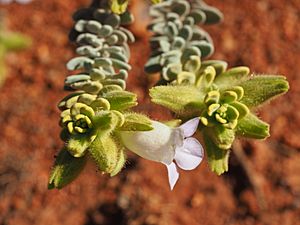Eremophila jucunda facts for kids
Quick facts for kids Eremophila jucunda |
|
|---|---|
 |
|
| Eremophila jucunda subsp. jucunda leaves and flower | |
| Scientific classification | |
| Genus: |
Eremophila (plant)
|
| Species: |
jucunda
|
Eremophila jucunda is a flowering plant from the figwort family. It grows only in Western Australia. This plant is a small to medium-sized bush with furry branches and leaves. Its flowers can be cream, lilac, or purple.
Contents
What Does This Plant Look Like?
Eremophila jucunda is a small to medium-sized bush. It can grow from about 0.4 meters (1.3 feet) tall on hard, stony ground to 0.8 meters (2.6 feet) tall on hillsides. Its branches and leaves are covered with grey or lemon-yellow hairs. These hairs are especially thick when the plant is young.
The leaves are shaped like a spear or an egg. They are usually 8.5 to 20 millimeters (0.3 to 0.8 inches) long and 2.5 to 5.5 millimeters (0.1 to 0.2 inches) wide.
The flowers grow one by one where the leaves meet the stem. Each flower sits on a stalk that is 3 to 9 millimeters (0.1 to 0.4 inches) long. This stalk is also covered in hairs. There are 5 pale yellowish-green to purplish-brown sepals. Sepals are like small leaves that protect the flower bud. They are usually 9.5 to 17 millimeters (0.4 to 0.7 inches) long. These sepals get bigger after the flower blooms. They are also covered with hairs.
The petals are 17.5 to 28.5 millimeters (0.7 to 1.1 inches) long. They join together at the bottom to form a tube shape. The outside of this tube can be white, cream, violet, or purple. The inside is white, sometimes with purple spots. The outside of the petal tube is mostly smooth, but the inside is full of long hairs. The 4 stamens (the parts that make pollen) are completely hidden inside the petal tube.
This plant flowers from July to September. After flowering, it produces oval or cone-shaped fruits with a pointed end. These fruits are 5 to 8.5 millimeters (0.2 to 0.3 inches) long.
Its Name and Types
Robert Chinnock officially described this plant in 2007. He published his description in a book called Eremophila and Allied Genera: A Monograph of the Plant Family Myoporaceae. The second part of its scientific name, jucunda, is a Latin word. It means "pleasant," "agreeable," or "delightful."
There are two main types, or subspecies, of Eremophila jucunda:
- Eremophila jucunda subsp. jucunda: This type has cream to lilac-colored flowers. Its young branches, leaves, and sepals have bright yellow hairs. The outside of its petal tube also has hairs.
- Eremophila jucunda subsp. pulcherrima: This type has lilac to light purple flowers. Its young parts have grey hairs. The outside of its petals is smooth (without hairs).
Where Does It Grow?
Eremophila jucunda subsp. jucunda grows in many places. You can find it on hills, mountain ranges, and flat plains. These areas are between Sandstone and Mount Vernon in the Gascoyne, Murchison, Pilbara, and Yalgoo regions of Western Australia.
The subspecies pulcherrima mostly grows on slopes and rocky hills. It is found between Paraburdoo and Newman, also in the Gascoyne, Murchison, and Pilbara regions.
Is It Safe?
Both types of E. jucunda are considered "not threatened." This means they are not in danger of disappearing. The Western Australian Government's Department of Parks and Wildlife keeps track of this.
Growing This Plant
This type of Eremophila grows best in warm, inland areas. If you try to grow it in southern Australia, it might get sick with fungal diseases.
The easiest way to grow new plants is by grafting. This means joining a piece of Eremophila onto the roots of another plant called Myoporum. You should plant it in soil that drains water well and in a sunny spot. It only needs water sometimes during a long dry period. However, it can be damaged by frost, which is very cold weather.


